Ethernet Evolution: To 100 Gb/s and Beyond
Since its development in the early 1970s, Ethernet has constantly evolved to support emerging demands of local area computer networks.
Ethernet originally used a shared coaxial cable as its communication media, but migrated to unshielded twisted-pair, point-to-point links that increased bandwidth as well as reach from local area networks (LANs) to wide area networks (WANs). The technology’s standardization by IEEE in 1982, together with the introduction of the World Wide Web, further accelerated the growth and subsequent domination of Ethernet in network topography. The copper media utilized to transmit Ethernet also expanded into fiber optic and wireless transport to address bandwidth demand and expansion in these growth markets.
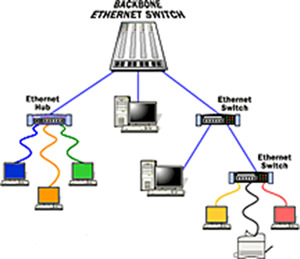 Over the years, Ethernet bandwidth has increased dramatically. Starting with the original Ethernet operating at 10Mbit/s, a progression of advances included Fast Ethernet at 100Mbit/s and Gigabit Ethernet at 1Gbit/s. More recently, 10 Gigabit Ethernet provided the speed needed by new applications. To a large degree, these upgrades were driven by stepped-up processor speeds, and they enabled networks to avoid communication bottlenecks.
Over the years, Ethernet bandwidth has increased dramatically. Starting with the original Ethernet operating at 10Mbit/s, a progression of advances included Fast Ethernet at 100Mbit/s and Gigabit Ethernet at 1Gbit/s. More recently, 10 Gigabit Ethernet provided the speed needed by new applications. To a large degree, these upgrades were driven by stepped-up processor speeds, and they enabled networks to avoid communication bottlenecks.
Throughout the evolution to 1Gb Ethernet, the eight-position 8P8C connector has been the mainstay of Ethernet connectivity. This remarkable copper connector is a direct descendent of the modular connectors developed by Bell Laboratories in 1972 for use in telephony applications. In networking applications, it is commonly referred to as the Ethernet, or RJ45, connector.
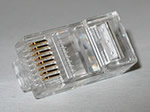 These low-cost connectors are terminated to wire using a simple one-step insulation displacement process that requires a single tool, ensuring that the quality of the connection is independent of operator skill. The gold-plated flat blade-to-spring wire contact has proven to be highly reliable in a wide variety of challenging environments.
These low-cost connectors are terminated to wire using a simple one-step insulation displacement process that requires a single tool, ensuring that the quality of the connection is independent of operator skill. The gold-plated flat blade-to-spring wire contact has proven to be highly reliable in a wide variety of challenging environments.
RJ45 connectors have remained the separable interface of choice for all but long-haul connections, even as system speeds far exceed what they were originally designed for.
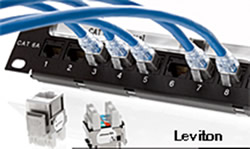 The industry may now be at the point of determining if the venerable RJ45 connector will continue its reign. Although the 10GBase-T specification for 10Gb Ethernet was released in 2002, it is just now beginning to ramp up in volume applications. Optimized but backward-compatible RJ45 connectors terminated with Cat 6a cable are capable of performing in lengths from 10 feet to 100 meters.
The industry may now be at the point of determining if the venerable RJ45 connector will continue its reign. Although the 10GBase-T specification for 10Gb Ethernet was released in 2002, it is just now beginning to ramp up in volume applications. Optimized but backward-compatible RJ45 connectors terminated with Cat 6a cable are capable of performing in lengths from 10 feet to 100 meters.
Years of successful 1Gb Ethernet implementation using RJ45 connectors has led to an attractive migration path to 10Gb Ethernet without changing the wiring infrastructure. 1Gb Ethernet links can easily be aggregated to 10Gb links using RJ45 cable assemblies. A number of factors ― including high power consumption, port density, ultimate bandwidth, cable length limitations, cost of enabling chips, and the PCB space they consume ― are encouraging users to consider alternatives.
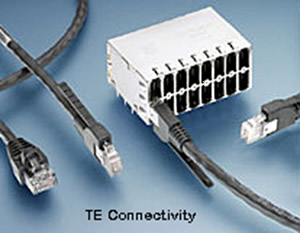 Some suppliers have proposed modified RJ45-type connectors that feature doubled port density. The RJ Point Five connector system from TE Connectivity is a proprietary interface capable of supporting 10Gb Ethernet using Cat 6a cable.
Some suppliers have proposed modified RJ45-type connectors that feature doubled port density. The RJ Point Five connector system from TE Connectivity is a proprietary interface capable of supporting 10Gb Ethernet using Cat 6a cable.
Demand for lower power consumption and increased port density in servers and switches is driving interest in SFP+ small form-factor pluggable connectors as an alternative to RJ45 connectors. Each SFP+ connector is capable of delivering 10 Gb/s per channel, and multiple connectors can be ganged and stacked for maximum I/O density.
Copper cables up to 15 meters can address the majority of applications within and between racks. Use of SFP+ connectors also gives system designers the flexibility of utilizing fiber optic links that let cables reach 300 meters and beyond.
A universal, PCB-mounted EMI cage and receptacle assembly accepts either passive or active direct-attached copper cables or fiber optic transceiver modules. Fiber optic cables terminated in LC connectors have the advantage of providing far higher bandwidth than copper, a factor that can assure system operators that their cabling infrastructure will not become obsolete as data rates continue to rise. Although high-speed optimized RJ 45 connectors and receptacles will continue to be used, SFP+ connectors have become the separable interface predominantly chosen by early adopters of new 10Gb Ethernet equipment.
The next step in the progression to higher Ethernet performance is the 40Gb Ethernet described in the IEEE 802.3ba standard ratified in 2010. Top-of-rack applications often require the ability to aggregate multiple 1GB or 10GB Ethernet links, making 40Gb Ethernet an attractive option.
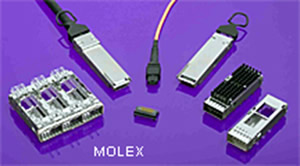
QSFP+ connectors are fully compatible with the 40Gb/s requirements of the IEEE standard, and appear to be the ideal choice. Having four individual 10Gb/s channels in a single pluggable module provides up to 96 ports per line card. System designers have the choice of I/O that includes direct-attached copper cables as long as 7 meters, and multimode and single-mode fiber optic cables terminated in MPO connectors up to 40 kilometers in length. Active optical cable assemblies are also available.
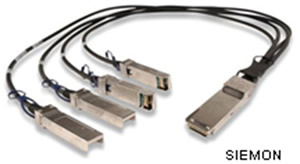 Surface-mounted host board connectors, single and ganged EMI cage assemblies, and terminated cable assemblies are available from such manufacturers as Amphenol, FCI, Molex, Samtec, and TE Connectivity.
Surface-mounted host board connectors, single and ganged EMI cage assemblies, and terminated cable assemblies are available from such manufacturers as Amphenol, FCI, Molex, Samtec, and TE Connectivity.
Breakout cable assemblies that terminate four SFP+ connectors to one QSFP+ connector can be used to aggregate four 10G server ports to one 40 G switch port.
Demand for ever-faster links continues to drive the evolution of Ethernet to higher transfer rates. Widespread adoption of multi-core servers, virtualization, network storage, and data center aggregation is stimulating the development of 100 Gb Ethernet.
Choosing a connector for 100 Gb Ethernet becomes a bit more fuzzy. One option under consideration for the IEEE 803.3bj specification is an optimized QSFP+ connector and cable running four lanes at 25Gb/s per lane. This approach allows designers to continue using the familiar QSFP+ interface, but there are nagging technical issues, including cost of the chipsets, thermal management, PCB material, and footprint layout. Some of these are interface-related, but others must be solved at the system level.
While most 100Gb/s links are expected to be implemented using fiber, the IEEE 802.3bj specification includes 4 x 25 copper options for shorter links (to five meters).
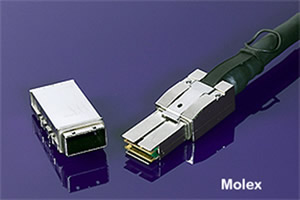
A newer interface in the race to support 100Gb Ethernet is the CXP connector. It provides up to 12 10Gb/s links in a package slightly larger than the QSFP+. Although CXP was initially developed for Infiniband, it enables 10 x 10Gb/s channels for 100Gb Ethernet.

The technical advantages of lower speeds per lane may be balanced by PCB footprint congestion that results from the more differential pairs. This copper connector will also be limited to relatively short-run applications, although CXP active optical cable assemblies are available.
In campus and metro applications where 100Gb Ethernet is expected to grow, the CFP interface might be a better solution. This optical transport module is specifically designed for long-haul optical transmission. Electro-optic conversion in these modules can multiplex 10 10Gb/s electrical lanes to four 25Gb/s optical links.

PCB-mounted connectors and card cage assemblies feature integrated heat sinks, and are available from manufacturers including TE Connectivity and Yamaichi.
The initial iteration of CFP is a relatively large and power-hungry module, but the CFP roadmap includes a CFP-2 that doubles the original faceplate density, and the CFP-4 version is expected to double that density again.
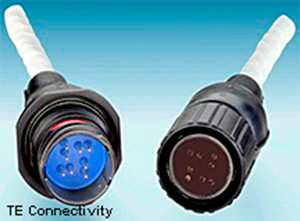 Adoption of Ethernet is not limited to commercial network installations. TE Connectivity recently introduced its CEELOK FAS-T connector for use in 10Gb Ethernet aerospace, defense, and marine applications. This rugged circular connector features simple field termination and repair along with true 100-ohm impedance that’s compatible with Cat5e and Cat 6a cable. A metal backshell provides 360 degrees of shielding to isolate sensitive signals from electromagnetic interference.
Adoption of Ethernet is not limited to commercial network installations. TE Connectivity recently introduced its CEELOK FAS-T connector for use in 10Gb Ethernet aerospace, defense, and marine applications. This rugged circular connector features simple field termination and repair along with true 100-ohm impedance that’s compatible with Cat5e and Cat 6a cable. A metal backshell provides 360 degrees of shielding to isolate sensitive signals from electromagnetic interference.
Although there has been some implementation of 40Gb and 100Gb Ethernet, the volumes for switch uplink and inter-chassis connections have been relatively small, giving the market time to evaluate the various interconnect options. 10Gb Ethernet is now in the adoption stage, creating more immediate revenue opportunities for connector manufacturers.

Leading suppliers such as FCI Electronics have begun promoting families of their products aimed specifically at current and next-generation Ethernet applications.
The XLerate portfolio addresses the needs of 10Gb, 40Gb, and 100Gb Ethernet, as well as that of InfiniBand, with both copper and fiber interconnects in increments of 1X, 4X, and 12X data rates.
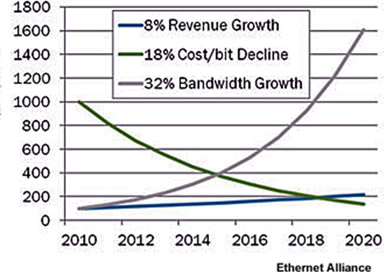 There is no reason to believe that 100Gb/s will be the ultimate limit of Ethernet networks. The Ethernet alliance sees continuing demand for bandwidth escalation while the cost per bit decreases.
There is no reason to believe that 100Gb/s will be the ultimate limit of Ethernet networks. The Ethernet alliance sees continuing demand for bandwidth escalation while the cost per bit decreases.
[hr]
No part of this article may be used without the permission of Bishop & Associates Inc.
- Optics Outpace Copper at OFC 2024 - April 16, 2024
- Digital Lighting Enhances your Theatrical Experience - March 5, 2024
- DesignCon 2024 in Review - February 13, 2024





